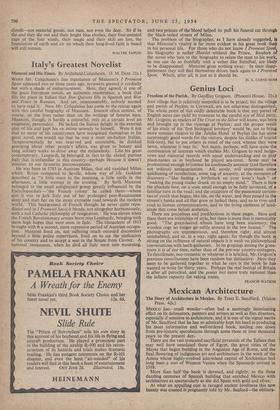Mexican Architecture
The Story of Architecture in Mexico. By Trent E. Sandford. (Vision Press. 42s.) Mexico has—small wonder—often had a seemingly intoxicating effect on its delineators, painters and writers as well as film directors, especially if sensitive to architecture, and it is one of the signal merits of Mr. Sandford that he has so admirably kept his head in producing his most informative and well-ordered book, leading one down from pre-historic speculations through some three or four thousand years to the present day.
There are the vast truncated sacrificial pyramids of the Taltecs that may well have antedated those of Egypt, the great cities of the Mayas that began building in the Augustan Age of Rome, and the final flowering of indigenous art and architecture in the work of the Aztecs whose highly-evolved lake-island capital of Xochimilco had long been a sort of Western Venice when the Spaniards arrived in 1519.
More than half the book is devoted, and rightly, to the three dazzling centuries of Spanish building that enriched Mexico with architecture as spectacularly as she did Spain with gold and silver.
At what an appalling cost in ravaged ancient loveliness this new beauty was created is poignantly told by Mr. Sanford—the oblitera- on of Montezuma's fabled capital being typical of the Conquiita- ores' consuming lust: There was but one course of action left, to engage in the systematic destruction of the city. Every breach in the causeway, every canal must be so solidly filled that it could not again be opened. To accomplish this not a building could be spared. 'The water should be converted into dry land' for the movements of the cavalry and the artillery. It was not an easy decision for Cortes to make, to 'destroy that city, 'the most beautiful in the world,' which he wanted to add to the empire of Spain ... the Spaniards advanced on the wreckage, until but one corner of the city remained. The terraced houses had become a fill of rubbish where the. canals had been; the palaces, the temple enclosure, the treasure chambers, and the gardens had all been destroyed. The broad avenues and sparkling canals, the brightly coloured flower-filled patios and terraces, the gay market places, were but desolate ruins ... what was left of the once magnificent city was burned. The destruction was complete. Thus ended a conquest too fabulous, too fantastic for fiction. The eight centuries of training, the eight centuries of looting and killing, combined with the fanatical religious zeal, had done their work. The outlet had been found.
But though the historical, geographical and scenic backgrounds are vividly presented, the architectural thread is always clear, twist as Pmay through the first Gothic fortress-monasteries, the intricate lateresque (silversmith style), High Renaissance, Baroque, to the extravagant Churrigueresque and beyond, even to Modernismus and Diego Rivera's murals.
Having quoted— Mexican history can be divided into three parts: first, the period before the Spanish Conquest, about which nothing is known; second, the three hundred years of Spanish rule, during which nothing happened; and third, the last hundred years or so, about which the less said the better— the author has however contrived with American thoroughness to concentrate the essence of the exhaustive bibliography that he gives into a single volume that nonetheless has a .smooth continuity through his own researches and observation on his wide and often utlandish travels. Most of the hundred or so brilliantly dramatic hotographs are his too, and although, as in the text, his bias is chitectural, one feels that he has given one an illuminating glimpse to the whole make-up of a strange and lovely land, for whose welfare and future integrity he is deeply concerned.
CLOUGH WILLIAMS-ELLIS



































 Previous page
Previous page